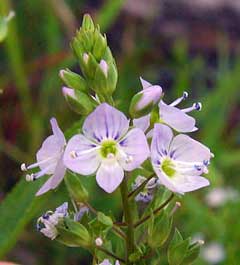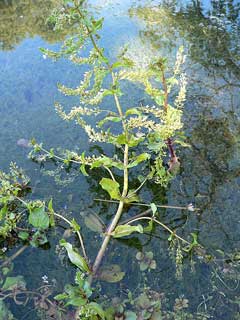 |
|
|
 |
| commons.wikimedia.org/wiki/User:Stan_Shebs |
Translate this page:
Summary
Physical Characteristics

 veronica anagallis-aquatica is a PERENNIAL growing to 0.3 m (1ft).
veronica anagallis-aquatica is a PERENNIAL growing to 0.3 m (1ft).
It is not frost tender. It is in flower from June to August. The species is hermaphrodite (has both male and female organs) and is pollinated by Flies. The plant is self-fertile.
Suitable for: light (sandy), medium (loamy) and heavy (clay) soils. Suitable pH: mildly acid, neutral and basic (mildly alkaline) soils. It cannot grow in the shade. It prefers wet soil and can grow in water.
UK Hardiness Map
US Hardiness Map
Synonyms
V. anagallis.
Plant Habitats
Pond; Bog Garden;
Edible Uses
Edible Parts: Leaves
Edible Uses:
Leaves - raw or cooked[46, 61]. Rich in vitamin C[2]. A subtle flavour[132], the leaves can be added to salads or used as a potherb[183]. When used in salads they go better with a lemon dressing than vinegar[183]. The leaves are often available in winter.
References More on Edible Uses
Medicinal Uses
Plants For A Future can not take any responsibility for any adverse effects from the use of plants. Always seek advice from a professional before using a plant medicinally.
Alterative Antiscorbutic Appetizer Diuretic Poultice Vitamin C
The root and the leaves are alterative, appetizer and diuretic[218, 240]. The leaves are used in the treatment of scurvy, impurity of the blood etc[240]. The plant is bruised and applied externally as a poultice on burns, ulcers, whitlows, etc[240].
References More on Medicinal Uses
The Bookshop: Edible Plant Books
Our Latest books on Perennial Plants For Food Forests and Permaculture Gardens in paperback or digital formats.

Edible Tropical Plants
Food Forest Plants for Hotter Conditions: 250+ Plants For Tropical Food Forests & Permaculture Gardens.
More

Edible Temperate Plants
Plants for Your Food Forest: 500 Plants for Temperate Food Forests & Permaculture Gardens.
More

More Books
PFAF have eight books available in paperback and digital formats. Browse the shop for more information.
Shop Now
Other Uses
References More on Other Uses
Cultivation details
Easily grown in a moderately fertile wet soil or in shallow water[1, 200]. Prefers cool summers[200]. Plants are occasionally cultivated for their edible leaves in Japan[61].
References Carbon Farming Information and Carbon Sequestration Information
Temperature Converter
Type a value in the Celsius field to convert the value to Fahrenheit:
Fahrenheit:
The PFAF Bookshop
Plants For A Future have a number of books available in paperback and digital form. Book titles include Edible Plants, Edible Perennials, Edible Trees,Edible Shrubs, Woodland Gardening, and Temperate Food Forest Plants. Our new book is Food Forest Plants For Hotter Conditions (Tropical and Sub-Tropical).
Shop Now
Plant Propagation
Seed - sow autumn in a cold frame[200]. When they are large enough to handle, prick the seedlings out into individual pots and plant them out in the summer. If you have sufficient seed it can be grown in situ in the autumn or spring. Division in autumn or spring[200]. Very easy, larger divisions can be planted out direct into their permanent positions. We have found that it is best to pot up smaller divisions and grow them on in light shade in a greenhouse or cold frame until they are growing away well. Plant them out in the summer or the following spring. Cuttings of young shoots root easily in the growing season, merely put them in water.
Other Names
If available other names are mentioned here
Native Plant Search
Search over 900 plants ideal for food forests and permaculture gardens. Filter to search native plants to your area. The plants selected are the plants in our book 'Plants For Your Food Forest: 500 Plants for Temperate Food Forests and Permaculture Gardens, as well as plants chosen for our forthcoming related books for Tropical/Hot Wet Climates and Mediterranean/Hot Dry Climates. Native Plant Search
Found In
Countries where the plant has been found are listed here if the information is available
Weed Potential
Right plant wrong place. We are currently updating this section.
Please note that a plant may be invasive in one area but may not in your area so it’s worth checking.
Conservation Status
IUCN Red List of Threatened Plants Status :

| Related Plants
|
| Latin Name | Common Name | Habit | Height | Hardiness | Growth | Soil | Shade | Moisture | Edible | Medicinal | Other |
| Veronica agrestis | Field Speedwell, Green field speedwell | Annual | 0.1 |
0-0
| | LMH | N | M | 1 | 1 | 0 |
| Veronica americana | American Brooklime, American speedwell | Perennial | 0.1 |
0-0
| | LMH | SN | WeWa | 2 | 1 | |
| Veronica anagallis-aquatica | Water Speedwell | Perennial | 0.3 |
-
| | LMH | N | WeWa | 2 | 2 | |
| Veronica arvensis | Corn Speedwell | Annual | 0.2 |
4-8
| | LMH | N | DM | 0 | 1 | 0 |
| Veronica beccabunga | Brooklime, European speedwell | Perennial | 0.6 |
4-8
| | LMH | SN | WeWa | 1 | 1 | |
| Veronica catenata | | Perennial | 0.0 |
-
| | LMH | N | WeWa | 1 | 0 | |
| Veronica chamaedrys | Germander Speedwell | Perennial | 0.5 |
3-7
| | LMH | SN | M | 1 | 1 | |
| Veronica hederifolia | Ivy-Leaf Speedwell | Annual | 0.5 |
-
| | LMH | N | M | 0 | 1 | |
| Veronica longifolia | Garden Speedwell, Long-Leaf Speedwell | Perennial | 1.0 |
4-10
| M | LMH | N | M | 1 | 0 | |
| Veronica officinalis | Common Speedwell | Perennial | 0.1 |
3-7
| | LMH | SN | DM | 1 | 2 | |
| Veronica peregrina | Necklace Weed, Neckweed, Hairy purslane speedwell | Annual/Biennial | 0.2 |
0-0
| | LMH | N | MWe | 0 | 2 | 0 |
| Veronica polita | Gray field speedwell | Annual | 0.3 |
0-0
| | LMH | N | M | 2 | 1 | |
| Veronica scutellata | Marsh Speedwell, Skullcap speedwell | Perennial | 0.1 |
5-9
| | LMH | N | WeWa | 1 | 0 | |
| Veronica spuria | bastard speedwell | Perennial | 0.5 |
3-7
| | LMH | N | M | 1 | 0 | |
| Veronica undulata | Undulate speedwell | Perennial | 1.0 |
0-0
| | LMH | N | MWe | 1 | 1 | |
| Veronicastrum axillare | | Perennial | 1.8 |
-
| | LMH | N | M | 0 | 2 | |
| Veronicastrum sibiricum | Blackroot | Perennial | 0.8 |
5-9
| | LMH | SN | M | 0 | 2 | |
| Veronicastrum virginicum | Beaumont's Root, Culver's root, Bowman's Root, Culver's Root, Black Root | Perennial | 1.2 |
3-9
| F | LMH | N | M | 0 | 3 | |
|
Growth: S = slow M = medium F = fast. Soil: L = light (sandy) M = medium H = heavy (clay). pH: A = acid N = neutral B = basic (alkaline). Shade: F = full shade S = semi-shade N = no shade. Moisture: D = dry M = Moist We = wet Wa = water.

Expert comment
Author
L.
Botanical References
17
Links / References
For a list of references used on this page please go here
Readers comment
© 2010, Plants For A Future. Plants For A Future is a charitable company limited by guarantee, registered in England and Wales. Charity No. 1057719, Company No. 3204567.